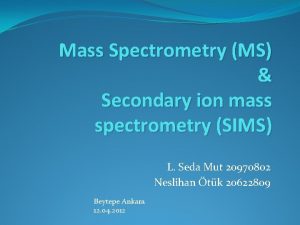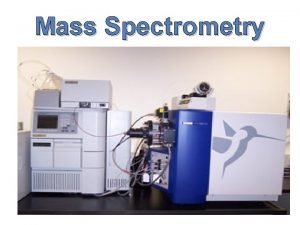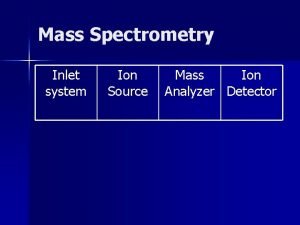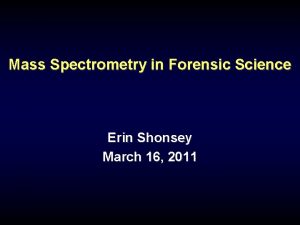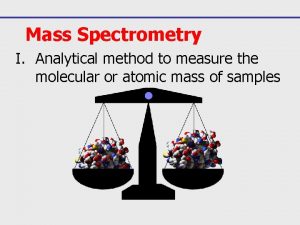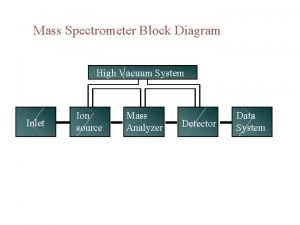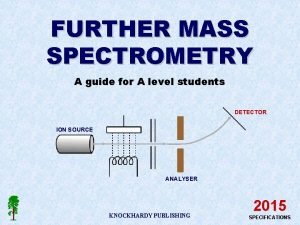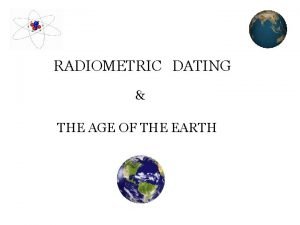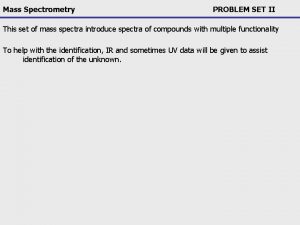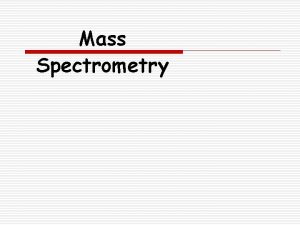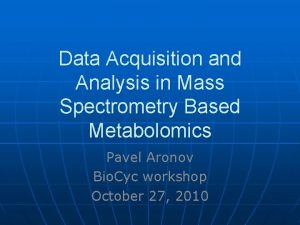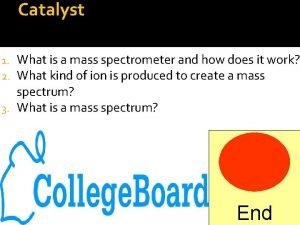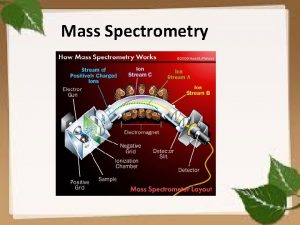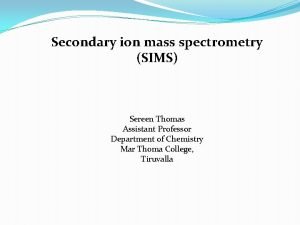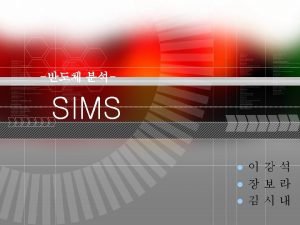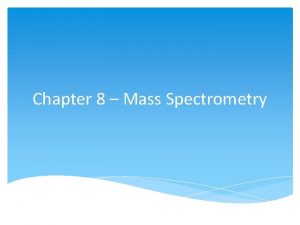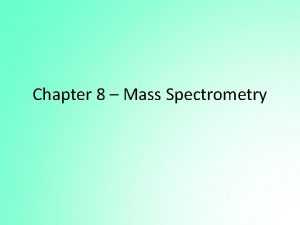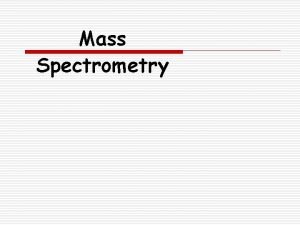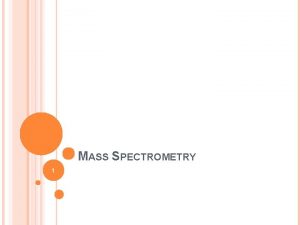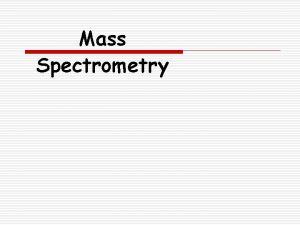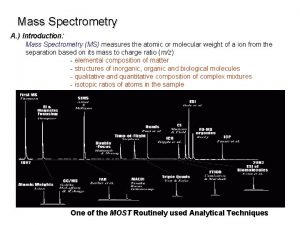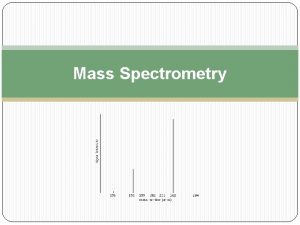Secondary Ion Mass Spectrometry A look at SIMS















- Slides: 15

Secondary Ion Mass Spectrometry A look at SIMS and Surface Analysis

Secondary Ion Mass Spectrometry What are Secondary Ions? • Ions created from the interaction between a surface and an ion beam (the primary ions) • Require high vacuum (≤ 10 -6 torr) in order to minimize ion-ion interactions • Analyzed using a mass spectrometer • Studies are used to gather information about the surface being analyzed and can fall in to two categories o Dynamic SIMS – used for bulk analysis using a DC ion beam and a QMS o Static SIMS – used for atomic monolayer analysis using a pulsed laser and a TOF

Target of SIMS Studies • Typically flat surfaces or rods – Cu. Be – Al • Rapidly growing interest in studying 3 D – Organometallics and films from metal or semiconductor surfaces • These trends demand that the Mass Spectrometer have – Better Resolution

MAX-CS Probes are the Proven Solution SIMS Analysis Features of MAX Probe Systems • Powerful research grade instruments. o Best performance of flange mounted systems o Heart of Extrel’s Vera. Spec Mass Spectrometer Systems o Widest array of options of any of our systems • Mass Ranges – 50, 120, 500, 1000, 4000, 16000 maximum masses – Based off of quad size + RF frequency • Two Quadrupole Sizes • MS/MS option • Multiple ionization sources • Conical aperture on the Ionizer can be located close to the substrate to ionize the desorbed neutral compounds o Energy Filter Ionizer to differentiate between secondary ions and ionized neutrals in the chamber o Has fine control of the ionizer to perform “soft” ionization to retain the molecular ion without fragmentation

MAX-LT Probes Provide a Quality solution at an Affordable Cost Research grade performance at an affordable price. – 500 and 1000 amu mass ranges – Positive and negative ion detection Typical applications – Thermal Programmed Desorption (TPD) – Plasma and Chemical Vapor Deposition (CVD) Analysis – UHV Residual Gas

SIMS Analysis: Energy Filter Ionizer • High Energy ions (1 ke. V – 100 ke. V) – Not easily analyzed by QMS – Should be blocked from entering the analyzer • Center stop of the energy filter – Keeps neutrals from entering the analyzer • Blocks line-of-sight. • Excellent Energy Filtering – Cylindrical lens of energy filter – Bandpass lenses – • • above and below the cylinder Center stop Cone aperture – Allows close placement to the target surface • Greater sensitivity to the sputtered plume • On-axis energy filter – Fine energy scan – < 0. 6 e. V FWHM (full width at half maximum) resolution

Sim. ION Modeling of the Energy Filter Ionizer

Cu. Be Experiment • • The SIMS spectra for the Cu. Be alloy were collected using: MAX-120 with a tandem ionizer/energy analyzer o • • • 19 mm Quadrupole & 2. 1 MHz QC Base pressure: 1. 6 x 10 -9 Torr Primary ions: 2 ke. V Ar+ ions Incident angle (angle between the sample surface normal and the axis of the ion gun): ~ 80° • Collection angle (the angle between the sample surface normal and the axis of the SIMS probe): ~ 10° • All of the SIMS spectra were acquired after the sample had been sputtered with a much higher current of the Ar+ ions. o • • SIMS spectra are characteristic of the unoxidized sample surface Ions of different kinetic energy were selected by the energy analyzer Ions coming out of the energy analyzer were then mass analyzed by the quadrupole mass filter o The pass energy of the energy analyzer is set by the voltage applied to the main cylindrical lens of the energy analyzer and the kinetic energy of the selected secondary ions is close to

SIMS Spectra: 4. 8 e. V Pass Energy Copper Beryllium surface analysis

SIMS Spectra: 13. 5 e. V Pass Energy Copper Beryllium surface analysis

SIMS Spectra: 20. 2 e. V Pass Energy Copper Beryllium surface analysis

SIMS Spectra: 30. 0 e. V Pass Energy Copper Beryllium surface analysis

Pass Energy (e. V) Beryllium Intensity (m/z 9; k. CPS) Copper Intensity (m/z 63; k. CPS) 4. 8 360 <2 13. 5 120 54 20. 2 100 67 30. 0 92 36 SIMS Data Summary The Be+ and Cu+ ion intensities measured at different pass energies allowing for precise measurement of each compound

Solutions to SIMS Analysis • • Characteristics of the secondary ions: o Absolute ion intensities depend on the pass energy o The Be-to-Cu ion intensity ratio changes with the pass energy The Be+ and Cu+ ions from the bombarded Cu. Be alloy surface have very different ion energy distributions • • Cu+ ion intensity peaks around 20 e. V Be+ ions achieves its maximum intensity at a much lower kinetic energy

For More Information: Please visit us at Booth XXX Or on our website at Extrel. com
 Applications of mass spectrometry
Applications of mass spectrometry Look to the left look to the right
Look to the left look to the right Ion mobility spectrometry
Ion mobility spectrometry Schematic diagram of mass spectrometer
Schematic diagram of mass spectrometer How does mass work
How does mass work Inlet system in mass spectrometry
Inlet system in mass spectrometry Mass spectrometry in forensic science
Mass spectrometry in forensic science Quadrupole mass analyzer
Quadrupole mass analyzer 4-heptanone
4-heptanone Mass
Mass Dating
Dating Spectroscopy problem set
Spectroscopy problem set Rule of thirteen mass spectrometry
Rule of thirteen mass spectrometry Mass spectrometry data acquisition for gc/ms
Mass spectrometry data acquisition for gc/ms Khan academy mass spectrometry
Khan academy mass spectrometry Past paper
Past paper
